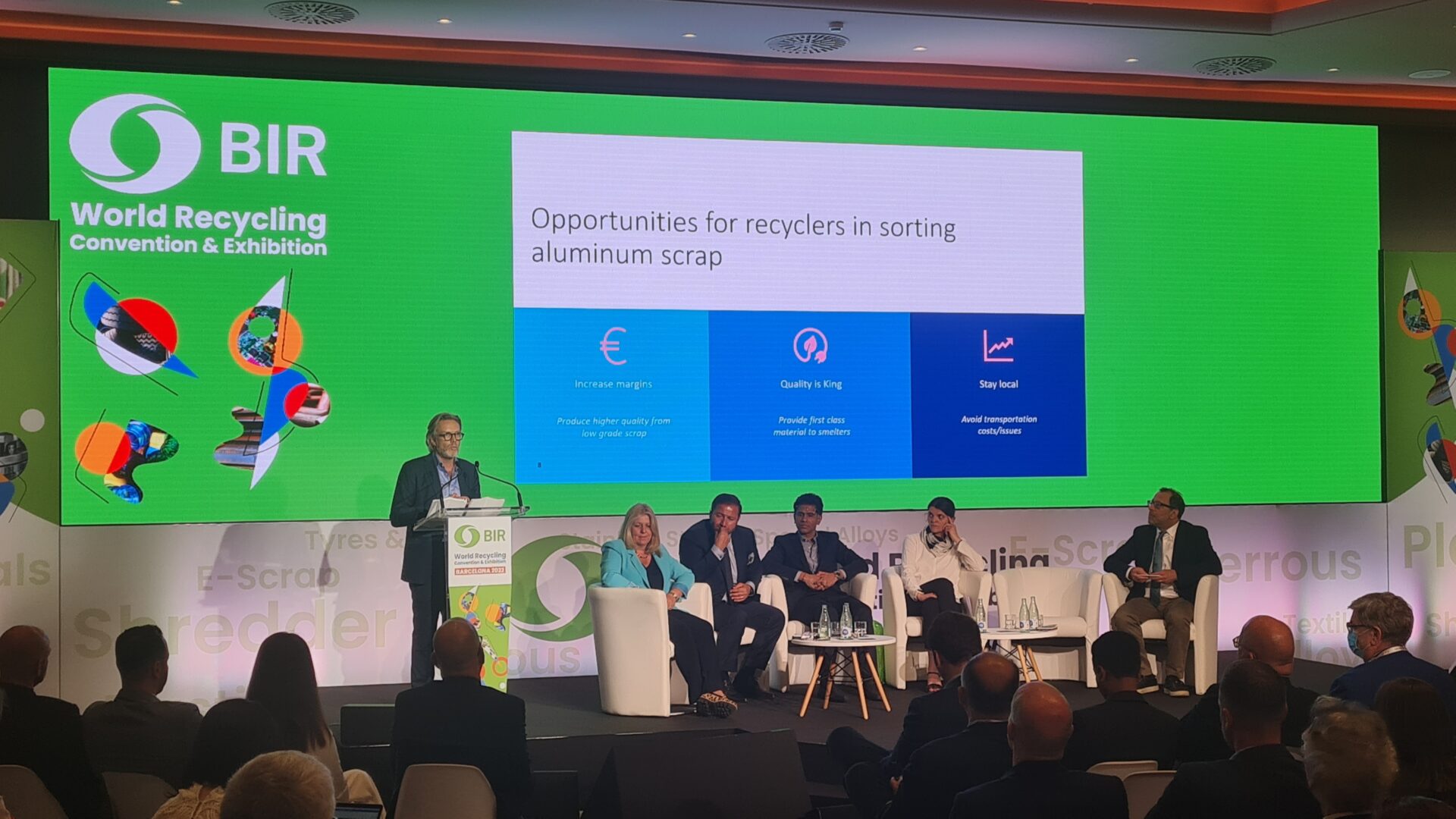Carbon emission reductions and the optimization of resource management have taken center stage in the recycling industry over the last decades with the aim to combat climate change. Aluminum plays a central role in the transition to a circular economy. At BIR Conference in Barcelona, held on May 23rd, Tom Eng went into more detail and shared the sorting system’s provider perspective.
He kicked off his presentation by describing the legislation in place and how its ambitious targets support the development of a circular economy. On a European level, the European Green Deal is one of the main drivers, aiming to improve waste management and decarbonize aluminum production while maximizing resource recovery and recycling. “We need legislation to drive change, incentivize recycling and turn scrap into high-quality recyclates. The future of circularity lies in waste. Why don’t we use it for new potential?”, stressed Eng.
Market forces and trends in the aluminum industry
Over the years, the demand for aluminum has steadily risen and is expected to further increase. According to the European Aluminum Vision 2050 report, the demand for aluminum is said to grow by 40% until 2050, stated Eng. This anticipated growth is mainly driven by the transportation, construction, and packaging sectors due to the material’s permanent properties that allow aluminum to be recycled without degrading. In the automotive sector, the production of lightweight vehicles to meet carbon emission targets, while the construction sector focuses on more energy-efficient buildings to comply with the EU Green Deal, and the packaging industry aims to increase recycled content.
Eng explained that in order to provide the volumes asked for by the market, these sectors must use secondary resources for two reasons. First and foremost, there is a limited capacity in Europe to produce primary materials. Secondly, aluminum processors need to meet increasingly stringent quality requirements and improve their environmental credentials.
Today 36% of the metal supply is covered by recycled aluminum. Many brand owners are aiming for 100% recycled content and want to decrease their environmental footprint with low-carbon aluminum. “We’ve made great progress in decarbonizing metals, and there is even more potential that can be unfolded when we increase the recovery and recycling rates of aluminum”, commented Eng.
Recovering high-quality aluminum
Following the overview of the market, Eng put emphasis on how the industry can move closer to a circular economy. He referred to a quote from Greg Wittbecker, who only recently said that “We have been trading low-carbon aluminum for a very long time; we just call it scrap.” In response to this statement, Tom Eng explained that there is a surplus of scrap in Europe and consequently, a lot of hidden value and valuable resources that are worth recovering.
The challenge in prioritizing secondary over primary aluminum and trading recycled aluminum locally lies in the quality of the recycled product. Smelters and remelters can only use recyclates with virgin-like qualities that are suitable for higher grade applications.
On a more technical side, he described that aluminum processors who rely on sophisticated X-Ray technology have a competitive edge. “Tomra has a 15-year legacy in sorting aluminum from heavy metals. Our XRT technology is the world’s leading technology behind aluminum recycling and smelting, but now we’ve developed a way to process more material faster”, stressed Eng. Since smelters and refiners are under pressure to reduce costs while maintaining high quality, they look for an economically viable and profitable solution. With Tomra’s new X-Tract, processors are given the means to create consistently high-quality furnace-ready aluminum products, therefore reducing energy consumption. To highlight the flexibility of X-Ray sorting technology and the purity results it can achieve, Tom Eng showed a flowchart for two typical applications, Zorba and aluminum profile processing.
Primary vs. secondary aluminum
Using recycled aluminum instead of virgin materials provides both recyclers and the environment with numerous advantages. Eng summarizes these by stating that recyclers employing the latest sorting technology can process larger volumes of lower grade scrap and create low-carbon products of consistently high qualities that allow for selling at higher prices and domestic trade. Moreover, producing secondary aluminum is 95% less energy-intense compared to primary production and reduces the dependency on bauxite and carbon-intense primary aluminum imports. Going into more detail, Tom Eng highlighted that if we used recycled aluminum instead of imported primary materials, we could reduce CO2 emissions by 2050 which is equal to avoiding 39 million tons of CO2 emissions per year.
Followed by a general overview of the benefits, Tom Eng brought a tangible example from one of Tomra’s customers. By increasing secondary aluminum content in the production process, the remelter saved 1.5 Mio.€/year and moreover reduce energy consumption by 6%. The energy savings are mainly based on the fact that recycled materials require less energy in the furnace to melt. In addition, higher-quality scrap led to a raise in production capacity and extra revenues of 1 Mio.€/ year.
Closing the loop on aluminum
In his closing words, Eng recapped that there is a huge demand for aluminum, which can be supplied by secondary aluminum. “If we make use of the scrap we have and employ the respective sorting technology, we can maximize recovery rates and recycle larger volumes and provide the market with first-class aluminum recyclates. This, in turn, allows us to meet CO2 emission targets and make aluminum greener. Let’s close the loop together”, concludes Tom Eng.











